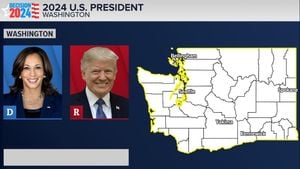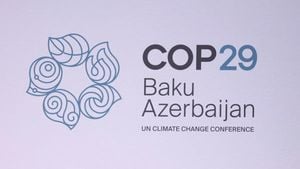A gray rhino—a predictable and long-foreseen disruption—has crashed headfirst onto the shores of American foreign policy: Donald Trump has won his second term as president of the United States. The elections of 2024 brought with them surprises, but this outcome, far more decisive than anyone could have expected, raises chilling questions about how Trump’s upcoming foreign policy will shape global relations.
Reflecting on his first term, where Trump's unpredictability and unconventional governance left many wondering about the future of U.S. foreign relations, we now have four years of experience, analysis, and political action to draw upon. Since his ascent to the presidency the first time around, the international climate has shifted. The world, once relatively more stable, is now fraught with tumultuous events and challenges.
Two main observations emerge as we contemplate Trump's second term. First and foremost, Trump is set to be surrounded by individuals who aren't just willing but eager to transform the machinery of U.S. foreign policy. Various factions will be angling for influence, some advocating radical changes to the bureaucratic traditions of American diplomacy. Unlike before, when moderate factions sometimes curtailed more extreme ambitions, it seems the radicals will have the upper hand this time around. They may aim to purge government ranks of those who are considered part of the so-called “deep state,” individuals the Trump team perceives as barriers to their vision.
Secondly, Trump’s core approach to international relations remains anchored in transactionalism. His first term saw deals predicated on immediate advantage rather than long-term strategy, and it's likely this will persist. Campaign rhetoric paints him and his administration as hard-nosed realists, yet the substantive policies often fell short of being truly realistic. Will it be possible for Trump to protect American interests effectively with this same mindset, especially as he faces heightened global challenges compared to his previous term?
One of the first hurdles for Trump will be the transition of power. This process, traditionally filled with protocol and cooperation, may see significant disruption under his administration. Trump’s historical aversion to established norms leaves many insiders wondering how or even if they will work with their outgoing counterparts. Notably, he's already dismissed part of the transition process, opting instead to lean heavily on loyalist groups like the Heritage Foundation's Project 2025.
The transition might not slow down thanks to these contributions from the politically aligned, but what does this mean for the continuity of American foreign policy? The essence of Trump’s approach signals significant shifts. He may opt for the informal vetting methods to select key personnel, allowing him to bypass systemic checks typically placed on government appointments.
Such steps, radical as they might appear, could falsely assure many of his base even as they introduce new risks and unpredictabilities. Moving sure-footedness from the national stage to the fringes could harm heretofore reliable alliances. It’s clear he aims to populate his cabinet with more than mere loyalists; from figuring out who makes the cut to assessing their capabilities might be increasingly reliant on political capital over proven expertise.
The makeup of Trump's national security apparatus during his first tenure included three distinct cultures of leadership and policy influence, with the experts standing on the backfoot. The bulk of these candidates would likely not have been apt choices for previous administrations. The result was chaotic—Trump operatives attempting to implement radical policies with little room for seasoned diplomatic practice.
The primary group comprised officials who did have relevant expertise and were ready to attempt implementing Trump's agenda under chaotic conditions. For the most part, the successes attributed to this era can be linked to these professionals attempting to operate amid chaos. But challenges loomed, and the normally cautious expertise met the brunt of abrupt changes.
Another affinity group within Trump’s council was comprised of hard-charging national security hawks who believed they could steer policy decisions through inefficiencies and challenges. Trump's first national security advisers, such as H.R. McMaster and John Bolton, believed they could instill discipline and direction through aggressive participation. Their attempts proved futile. They found themselves subject to whims of decision-making where the usual diplomatic constraints ceased to exist.
Faced with the reality of Trump’s legislative ambitions tail-spinning out of control, many seasoned officials left or were forced out. Their criticisms of Trump for not only undermining strategic advancements but undermining American credibility abroad deepened. The turnaround began with claims of substantial successes, but those who attempted to govern under Trump often found themselves pushed out or sidelined.
What does this stage set for U.S. foreign policy moving forward? First, expect the threshold for what is considered acceptable within American foreign relations to be pushed to new extremes. With the extreme factions consolidatively influencing Trump’s thinking, there will be little filtering of ideas contrary to the radical viewpoints held by dedicated supporters. The potential for recklessness looms larger than ever.
Compounding matters, the prevailing notion of international alliances may shift. During his election campaign, Trump incessantly criticized NATO allies and questioned commitments to defense agreements. Should this rhetoric be translated to hallmarks of policy, longstanding relationships could be fractured. NATO, for example, could find itself susceptible to realignment—making it more transactional and perhaps leading to severe drawbacks, even weakening the alliance’s core commitments.
Trump's views of China and Russia pose similar threats. A heavily transactional methodology could devalue traditional alliances, putting at risk the diplomatic maneuvers painstakingly crafted over decades. If these methodologies remain unchecked, the geopolitical impact may catalyze competing global powers to act more brazenly than they might under the earlier U.S. administrations.
This turbulent foreign policy palette will invite external forces to capitalize on potential weaknesses. Countries like China could birth renewed tensions with aggressive tactics, as indicated by their lifestyle negotiations. Russia, meanwhile, might take bold measures to test commitments from the United States and its allies, emboldened by perceived vacuums created through alterations to diplomatic strategies.
American foreign policy, under Trump’s latest administration, draws severe existential risks outlined by threats of complacency and opportunism looming all around. It’s imperative to gauge how quickly the administration returns to the drawing board. If history is any indicator, Trump’s inclination to side-step the usual bureaucratic roadblocks tends to result instead in opportunist stances and partnerships devoid of established norms.
While details remain thin, the anticipated upheavals and the ensuing responses by allies hinge on one consistent question: Can Trump navigate this increasingly complex international environment? Given the chaotic nature attributable to his first term, how demonstrably effective will his foreign policy maneuvers prove to be? The central challenges, merely nascent now, expand upon his known tendencies for impulsively originating agreements attractive on paper but not emotionally or intellectually substantive enough to reinforce or embrace global alliances.
The overarching consequence is not merely political; it weighs on collective decision-making—pushing the international community to rethink and potentially recalibrate its relationships with the United States as tensions mandatorily erupt. The final outcome resonates with Trump’s capacity to act and influence what is quickly becoming a more dangerous array of international dynamics. The ramifications of his presidency will decidedly shape not just four more years, but potentially the decades of American foreign policy to come.



